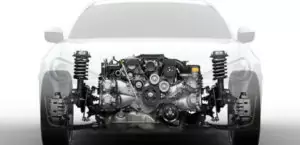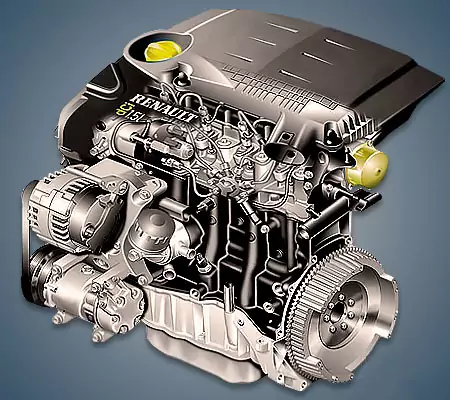The 1.5-liter Renault K9K or 1.5 dCi diesel engine has been produced by the concern since 2001 and is installed on a huge number of company models under the Renault, Nissan or Dacia brands. The same motor can be found under the hood of front-wheel drive Mercedes called OM607 and OM608.
The K-series include: K4J, K7J, K4M, K7M and K9K.
In 2001, a 1.5-liter diesel debuted on the second generation of the popular Clio model. It was quite a typical engine for its time with a Common Rail fuel system, a 4-cylinder cast-iron block, an aluminum 8-valve head without hydraulic lifters, a timing belt drive, a KKK or BorgWarner turbine and, of course, an intercooler.
Fuel systems from three manufacturers were installed on these engines: until 2009, Delphi was installed on all versions of units up to 100 hp, and Siemens was installed on powerful ones, then in 2009 Delphi replaced Bosch, and Siemens remained, but was renamed Continental. Low-power versions of this unit were equipped with a conventional BorgWarner KP35 turbocharger, and engine modifications over 100 hp with a BorgWarner BV39 variable geometry turbine. There are four generations of such engines under Euro 3, 4, 5 and 6 environmental standards, respectively.
Specifications
| Production years | since 2001 |
| Displacement, cc | 1461 |
| Fuel system | Common Rail |
| Power output, hp | 64 – 101 (1 gen. 2001 – 2005) 68 – 106 (2 gen. 2005 – 2010) 75 – 110 (3 gen. 2008 – 2016) 75 – 115 (4 gen. since 2012) |
| Torque output, Nm | 160 – 200 (1 gen. 2001 – 2005) 160 – 240 (2 gen. 2005 – 2010) 180 – 260 (3 gen. 2008 – 2016) 200 – 260 (4 gen. since 2012) |
| Cylinder block | cast iron R4 |
| Block head | aluminum 8v |
| Cylinder bore, mm | 76 |
| Piston stroke, mm | 80.5 |
| Compression ratio | 18.8 (1 gen. 2001 – 2005) 15.9 (2 gen. 2005 – 2010) 15.2 (3 gen. 2008 – 2016) 15.5 (4 gen. since 2012) |
| Hydraulic lifters | no |
| Timing drive | belt |
| Turbocharging | yes |
| Recommended engine oil | 5W-30, 5W-40 |
| Engine oil capacity, liter | 4.5 |
| Fuel type | diesel |
| Euro standards | Euro 3 (1 gen. 2001 – 2005) Euro 4 (2 gen. 2005 – 2010) Euro 5 (3 gen. 2008 – 2016) Euro 6 (4 gen. since 2012) |
| Fuel consumption, L/100 km (for Renault Scenic 2011) — city — highway — combined |
5.8 4.4 4.9 |
| Engine lifespan, km | ~400 000 |
| Weight, kg | 145 |
The engine was installed on:
- Dacia Duster 1 (HS) in 2010 – 2018; Duster 2 (HM) since 2018;
- Dacia Dokker 1 (K67) since 2012;
- Dacia Lodgy 1 (J92) since 2012;
- Dacia Logan 1 (L90) in 2005 – 2013; Logan 2 (L52) since 2012;
- Dacia Sandero 1 (B90) in 2009 – 2012; Sandero 2 (B52) since 2012;
- Infiniti Q30 1 (H15) in 2015 – 2018
- Mercedes A-Class W176 in 2013 – 2018; A-Class W177 since 2018;
- Mercedes B-Class W246 in 2013 – 2018; B-Class W247 since 2018;
- Mercedes CLA-Class C117 in 2013 – 2019; CLA-Class C118 since 2019;
- Mercedes GLA-Class X156 in 2014 – 2018;
- Mercedes Citan W415 since 2012;
- Nissan Almera 2 (N16) in 2003 – 2006;
- Nissan Juke 1 (F15) in 2010 – 2019;
- Nissan Micra 3 (K12) in 2005 – 2010; Micra 5 (K14) in 2017 – 2018;
- Nissan Note 1 (E11) in 2006 – 2013; Note 2 (E12) in 2012 – 2020;
- Nissan NV200 1 (M20) since 2009;
- Nissan Tiida 1 (C11) in 2007 – 2008;
- Nissan Qashqai 1 (J10) in 2007 – 2013; Qashqai 2 (J11) since 2013
- Renault Clio 2 (X65) in 2001 – 2005; Clio 3 (X85) in 2005 – 2013; Clio 4 (X98) in 2012 – 2019; Clio 5 (BF) since 2019;
- Renault Captur 1 (J87) in 2013 – 2019; Captur 2 (JB) since 2019;
- Renault Fluence 1 (L38) in 2010 – 2012;
- Renault Duster 1 (HS) since 2010;
- Renault Kangoo 1 (KC) in 2002 – 2008; Kangoo 2 (KW) since 2008;
- Renault Kadjar 1 (HA) since 2015;
- Renault Laguna 3 (X91) in 2007 – 2015;
- Renault Latitude 1 (L70) in 2011 – 2012;
- Renault Modus 1 (J77) in 2004 – 2012;
- Renault Megane 2 (X84) in 2002 – 2009; Megane 3 (X95) in 2008 – 2016; Megane 4 (XFB) since 2016;
- Renault Scenic 2 (J84) in 2003 – 2009; Scenic 3 (J95) in 2009 – 2016; Scenic 4 (JFA) since 2016;
- Renault Symbol 1 (L65) in 2002 – 2008; Symbol 2 (L35) in 2008 – 2012; Symbol 3 (L52) since 2012;
- Renault Talisman 1 (L2M) in 2015 – 2018;
- Renault Twingo 2 (C44) in 2007 – 2014;
- Suzuki Jimny 3 (FJ) in 2004 – 2009.
Disadvantages of the Renault K9K engine
- The most famous problem with such engines is cranking of the connecting rod bearings. This happens especially often with engines from Europe, where they change the oil every 30,000 km.
- The bulk of diesel engines until 2009 were equipped with the Common Rail Delphi system, which does not tolerate airing, a clogged fuel filter and bad diesel fuel. For any of these reasons, it begins to drive chips and primarily clogs the nozzles. Also, this metal pollen significantly reduces the life of the turbine and oil pump.
- The fuel system manufactured by Siemens or Continental is much more reliable, but its repair costs more money, some piezo injectors are several times more expensive. Therefore, we do not have an unambiguous opinion about which company’s equipment is better.
- Most diesel cars from Europe are equipped with a particulate filter and an EGR valve, which tend to clog.
- Much less often, such motors fail due to a drop in lubricant pressure in the system. This is due to the oil filter valve and the oil pump pressure reducing valve spring.







I change the time belt at 162,000Km
When to replace timing belt on this model?
In some country Renault says every 60 000 km in other country 90 000 km.
I’ve replaced the first time at 70 000 km the car now has 125 000 km and I’m wondering if I should do it at 130 000 km or at 160 000 km.
Car is a Clio IV 1.5 dCi 90 HP.
I think you need to do as the factory recommends for your country.
I used the same car with same engine. In my country, Renault said 80 000km or 4 years -whichever comes first- for timing belt change. I changed it when the car was 6 years old and at 65000km. The old belt looked fine, no cracks or signs of wear but nonetheless I think the best option is the comply with the 4 year interval.
They recommend 4 years or 60 000km in my country.
Being at 63 000km on this belt, I made an appointment for next week.
Thanks for the advices.
I have a 2010 1.5 diesel 68hp, after 5 years and around 93 000 km the belt shifted sideways towards the inside, where it began to hit lightly the egine to the point where the belt was frayed for at least 25%.
So i changed it right away!
My advice is never exceed 5 years and about the milage, 90 000km should be fine.